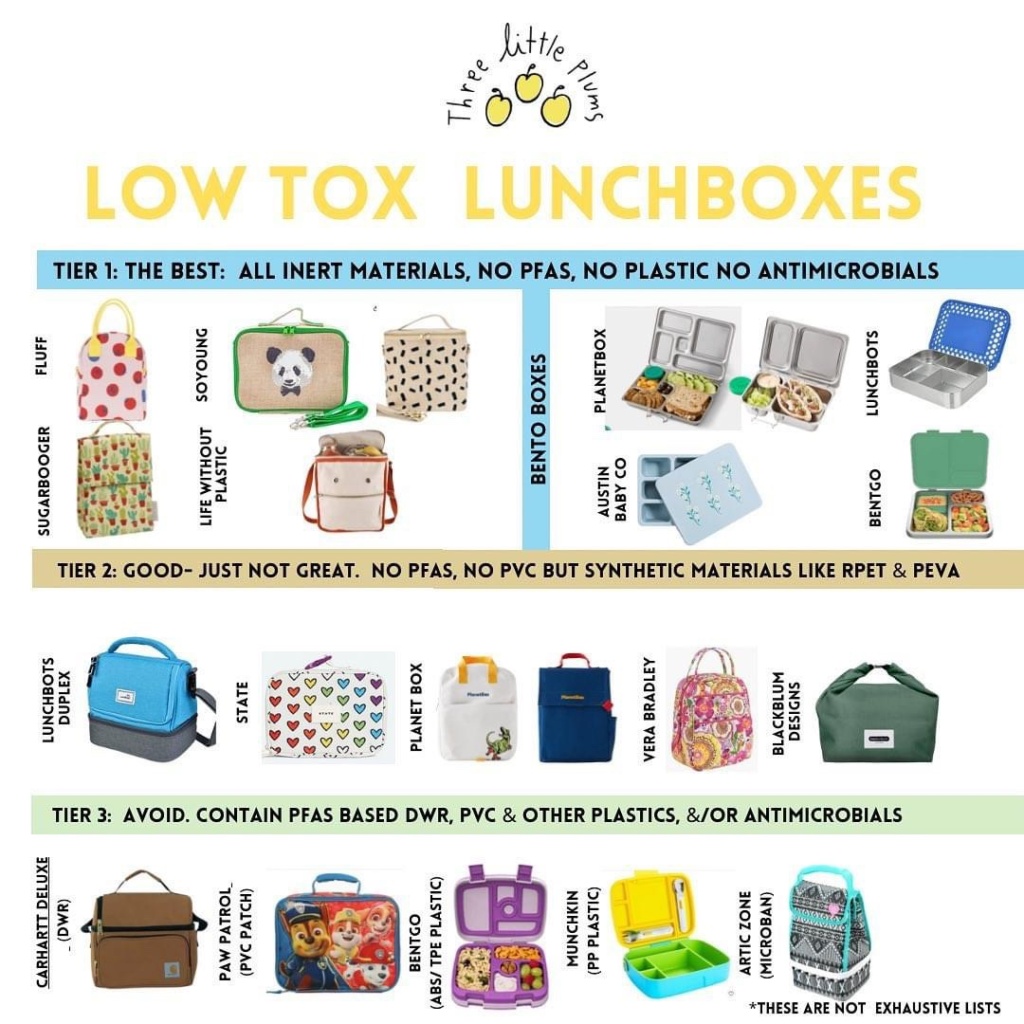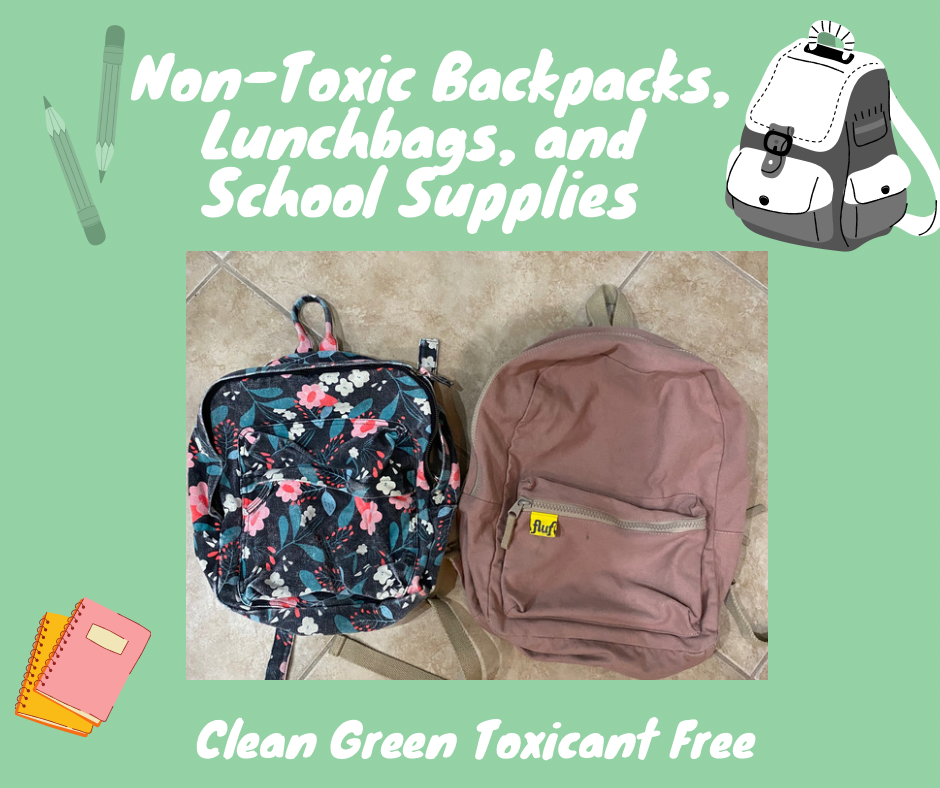Updated February 2025
When I recently searched for a new backpack and lunch bags for my pre-schooler, I was shocked at the lists of “non-toxic and eco friendly” options available. First of all, seeing those two phrases together is a red flag to me that the options will likely be neither of those things! I’m beginning to wonder if I should have named my blog something along the lines of “TRULY Non-Toxic” to set my recommendations apart from others.
This post may contain Amazon Associates affiliate links, that I may earn small amounts from. See the bottom of this page for more details.
Products labeled as eco-friendly these days are usually made out of recycled materials, often plastic bottles. But let’s be clear, repurposed plastic is still plastic and is not inherently eco-friendly. Yes, by using recycled materials, it may have prevented the use of virgin material, but it is still plastic and is not infinitely recyclable. Plastic never actually biodegrades, rather it just turns into smaller and smaller fragments and micro plastics, which poison our bodies, waterways, and have found their way into animals in the deepest parts of the ocean. We contribute to this directly when we wash items made with recycled plastic, or other synthetic fabrics like Polyester, which is made of petroleum. Also, plastic bottles leach chemicals when heated (…. so that would include washing machines and dryers …).
What would be truly eco-friendly is using organically grown natural fabric, which can also be recycled into fabric again, and then eventually will biodegrade. To phrase it generally, non-toxic products are almost always also eco friendly. But it is usually not the case the other way around. Many people assume eco friendly means the same thing as non toxic, and that is incorrect!
In the scheme of things, this isn’t a big concern or priority to buy organic since it’s not touching skin the way clothing would. However, I like to research the very best options before I make a choice. Also, I’ve reached a point in my non-toxic journey that I now wash organic clothes and bedding more than non-organic, so it makes sense to get an organic fabric backpack and lunch bags because I want to wash it regularly and don’t want toxic fabrics contaminating my other laundry.
The bad things to avoid on bags are waterproofing (such as DWR or PFAS) and flame retardants. Also the printed designs on non-organic items sometimes contain PVC.
THE BEST BACKPACK OPTIONS
1. Terrathread makes regular and a mini backpack. GOTS certified organic cotton. Adults can use those too! I mean, adults can use any of the options on this list, especially if you are like me and carry a small kids backpack instead of a purse! I bought their mini backpack for my kindergartner. It fits a standard size folder. When I got the bag I noticed brass hardware, so I asked Terrathread about it and they said it is tested lead free. They still need to get back to me about the YKK zippers. Here is a post where I explain about the worry with brass.
2. Coqenpate. Tiny. Cute animal designs. GOTS certified and compliance with environmental social standards in accordance with ILO (International Labour Organisation) rules, traceability from cotton cultivation to clothing.
3. Fluf. Amazon Associates link: https://amzn.to/3rJ2mq1. Small and tiny sizes. GOTS Organic cotton but has Slight padding in back made with 100% recycled polyester felt (made from recycled water bottles). Very cute, especially the tiny ones. They make lunch bags (Amazon Associates https://amzn.to/3rJ2mq1) and snack bags too (Amazon Associates https://amzn.to/3jBNR3F) and I have some of those.
4. SoYoung. Not organic, but made of natural fabrics. Two sizes. Cute animal designs. They make lunch bags too.
5. Rawganique. It is quite expensive though! And I’m not aware if there are certifications to ensure the hemp is really organic? If not it can be problematic.
6. For young kids who don’t even carry a backpack themselves, you can use an organic cotton canvas tote bag. They fit artwork better than a tiny backpack. Backpacks are better for distribution of weight on the shoulders, but for often it is the parents carrying it, and there is very little weight and a very short distance of carrying it.
“BETTER” BACKPACK OPTIONS:
I avoid polyester, but if you’re looking for “better” polyester options: Hannah Anderson makes polyester backpacks without PVC. Fjallraven may have some options such as poly/ cotton blends, but be sure to ask the company through email for details because Not all of their bags are free of DWR. LLBean has at least some options without DWR.
LUNCH BOXES AND BAGS
This lunchbox/ lunch bag post is from the NBM blog. I was going to get the organic lunch bag from Etsy, but it doesn’t fully close at the top. So I went with Fluf (Amazon Associates: https://amzn.to/3vfB5NK. Now I hear that that Etsy shop does have a zipper top one, but I haven’t looked into it.
I also have the Lunchbots lunchboxes: (Amazon Associates links) https://amzn.to/3vkfzXT and https://amzn.to/3OcdiXy.
For insulated food containers, I use Hydro Flask. Other brands of insulated containers can have lead used to seal them together. This brand does not use lead. https://amzn.to/3EwKkS1
For other food storage containers, see this post I wrote.
Here is a graphic from another blogger (credit is within the image) from August 2022:

SCHOOL SUPPLIES
For things on the school supply list like sanitizer, soap, baby wipes, and disinfecting wipes, ask the teacher if your child can use less toxic products you provide. I list my choices in my master list blog.
To some extent we can’t know exactly what is best because these kinds of products aren’t required to share ingredients. IKEA is thought to be a better choice. And Filana crayons. Some other products are mentioned through my link. Elmers glue is thought to be ok. Avoiding scents (both fragrance or toxic smells) is a good start.
What about “non-toxic” labels on conventional products? They don’t mean much, and only apply to the product’s intended use and directions, I.e. paint or crayons used on paper, not on skin or chewed and swallowed. Art paint and markers are not formulated to be used on the skin, near the mouth or eyes. Anything put on skin will be absorbed to some degree. Also remember that many ingredients known to be toxic or carcinogen are perfectly legal and allowed in products like hand sanitizer and disinfecting wipes.
Choosing a Less-Toxic School
I also have a post Regarding Toxicity when Choosing a School.
If you would like to follow for new posts, “like” my Facebook page here:
https://m.facebook.com/CleanGreenToxicantFree/
***Thank you for visiting Clean Green Toxicant Free! I started this site simply because I want to help people and share information. I dig deep and seek the most truly non-toxic products, without bias. I am not paid to write anything and I don’t sell anything. In 2022 I became an Amazon Associate, which does NOT bias my recommendations. I may earn small dividends from purchases made after clicking my clearly labeled affiliate links (even if you don’t buy those specific items), which covers the costs I pay to maintain this site, at no cost to you. More info is on the About This Website page.***

